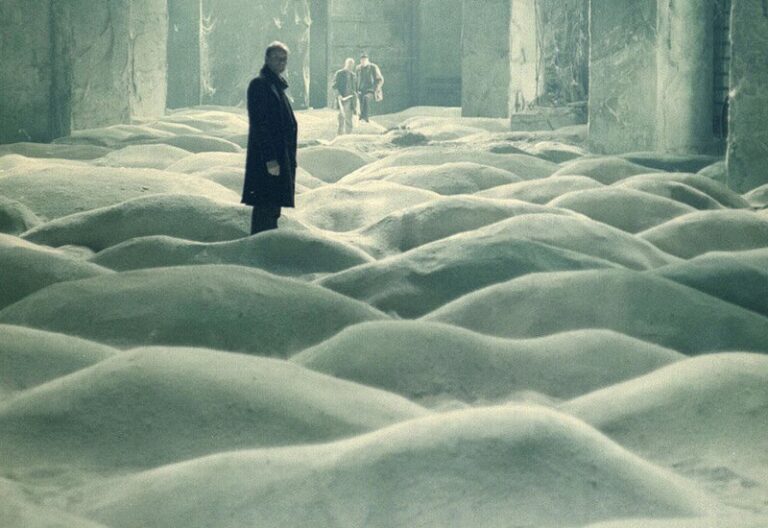new german cinema
est. 1966 – 1980s
New German Cinema or Neuer Deutscher Film, is a film movement that started in the late 1960s, and thrived throughout the 1970s and 1980s. It represents a significant turning point in the history of German filmmaking. This movement not only reinvigorated the German film industry but also left a lasting mark on world and arthouse cinema.
Published by: CinemaWaves Team | Filed Under: Film Movements
Origins of the
New German Cinema
New German Cinema emerged in the late 1960s as a reaction to the stagnation of the German film industry and the broader social and political transformations occurring in post-war West Germany. Following World War II, the German film industry struggled under the weight of its association with Nazi propaganda films and the destruction caused by the war.
In the 1950s and early 1960s, West German cinema was dominated by escapist, sentimental films known as “Heimatfilme,” which offered little reflection on the country’s troubled past or present realities. Meanwhile, younger filmmakers grew frustrated with the lack of creativity and relevance in mainstream cinema, which seemed out of touch with the new socio-political environment of the post-war reconstruction era.
The turning point for the movement came in 1962 when a group of young filmmakers, including Alexander Kluge and Edgar Reitz, signed the Oberhausen Manifesto, declaring the old German cinema dead and calling for a new form of filmmaking. This manifesto symbolized the birth of New German Cinema, advocating for films that would engage critically with contemporary society and embrace experimental, personal storytelling. The movement gained momentum with the support of state funding, particularly from West Germany’s film subsidy system, which allowed emerging directors to bypass commercial constraints.
Throughout the 1970s, New German Cinema developed as a major force in world cinema, with directors like Rainer Werner Fassbinder, Werner Herzog, and Wim Wenders gaining international recognition. Their films resonated with audiences at home and abroad, as they grappled with the complexities of post-war German identity and the challenges of modernity. The movement peaked during this decade, coinciding with the rise of new voices in other countries’ cinematic movements. However, by the 1980s, the movement began to lose momentum as filmmakers either transitioned to more mainstream projects or, like Fassbinder, died prematurely.

Characteristics of the New German Cinema
One of the defining features of New German Cinema was its focus on autobiographical elements and historical reflection. Filmmakers drew heavily from their personal experiences and Germany’s complex history, particularly the legacy of the Nazi era and the societal changes of the post-war period. This introspective approach allowed for a nuanced exploration of themes such as guilt, memory, and identity, as well as a critique of contemporary social and political issues. The economic miracle, generational conflicts, and the divided national identity during the Cold War were recurring topics in many films of this movement.
New German Cinema was marked by a willingness to experiment with narrative structure and visual techniques. Filmmakers employed nonlinear storytelling, innovative cinematography, and a blend of realism with surreal or symbolic elements to create films that were both thought-provoking and visually striking. This period also saw a focus on individualism, with many films portraying characters on a quest for identity and meaning in a rapidly changing world. This emphasis on the individual’s perspective resulted in highly personal and emotionally resonant stories.


Important New German Cinema Films
and Filmmakers
Rainer Werner Fassbinder was a leading figure of the New German Cinema, known for his prolific output and sharp social commentary. His films, such as “Ali: Fear Eats the Soul” (1974) and “The Marriage of Maria Braun” (1979), explore themes of power, exploitation, and human relationships within a shifting society. Fassbinder’s work often intertwined the personal and political, highlighting issues like racism, class, and gender dynamics in post-war Germany. His ability to present deeply flawed characters with empathy made his films both provocative and emotionally resonant.
Werner Herzog, another key figure, became renowned for his ambitious, physically demanding films that examine human nature and extreme conditions. “Aguirre, the Wrath of God” (1972) and “Fitzcarraldo” (1982) depict man’s obsessions and struggles against nature, blending real-life hardship with fiction. Herzog’s intense collaborations with actor Klaus Kinski added to the visceral power of his work, creating a raw, immersive cinematic experience. Herzog’s fascination with human endurance and the beauty of nature gives his films a haunting, transcendent quality.
Wim Wenders brought a contemplative, existential quality to his films, focusing on themes of alienation and identity. In films like “Alice in the Cities” (1974) and “Paris, Texas” (1984), Wenders used travel as a metaphor for self-discovery, capturing the emotional and physical dislocation of modern life. His reflective, meditative style emphasized human connection amid a rapidly globalizing world. Wenders’ films evoke a sense of longing, exploring how personal histories shape our understanding of the world around us.
Legacy and Influence of the New German Cinema
The New German Cinema significantly aided a cultural resurgence in Germany during the 1970s, offering a reflection of the country’s evolving social and political landscape. At a time when Germany was grappling with the aftermath of World War II, the Cold War, and internal political problems, the films of this movement helped shape a new, self-aware German identity. These films addressed previously taboo subjects, such as guilt and the lingering effects of fascism. In doing so, the New German Cinema mirrored the complexities of a society in transition.
In addition to its thematic and aesthetic legacies, the movement contributed to the international recognition of German film. Directors like Werner Herzog, Wim Wenders, and Rainer Werner Fassbinder garnered global acclaim, their works screened at prestigious film festivals and finding audiences far beyond Germany’s borders. Wenders’ “Paris, Texas” (1984) exemplified this by winning the prestigious Palme d’Or at Cannes.
The New German Cinema eventually brought new life into German filmmaking and is still revered for its long-lasting impact on arthouse cinema, influencing filmmakers globally with its daring, often uncompromising vision.
Refer to the Listed Films for the recommended works associated with the movement. Also, check out the rest of the Film Movements on our website.
The Berlin School Movement of the 2000s can be seen as an evolution of the broader landscape of German cinema, with its roots tracing back to the 1990s. The movement…
German Expressionism stands out as one of the most distinctive styles in the era of silent film. Expressionism, as an artistic movement, originally emerged in poetry and the…
Or La Nouvelle Vague, is one of the most iconic and influential film movements in the history of cinema. Emerging in the late 1950s and flourishing throughout the 1960s…
Postmodernist film emerged in the latter half of the 20th century, rooted in the broader cultural and philosophical movement of postmodernism. It started as a reaction…
The development of slow, or contemplative cinema is rooted in the history of film itself. Understanding slow cinema involves examining its evolution from early influences to its…
Bruno Stroszek is released from prison and warned to stop drinking. He has few skills and fewer expectations: with a glockenspiel and an accordion he ekes out a living…






